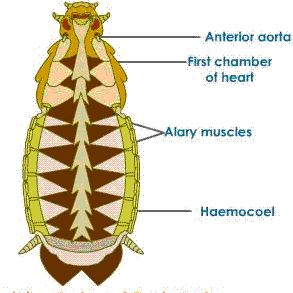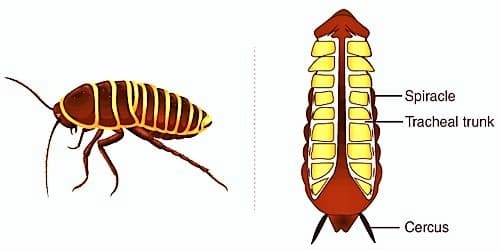Respiration is the procedure involves in the production of energy, naturally with the intake of oxygen and the release of carbon dioxide from the oxidation of multifarious natural substances.
Insect Respiratory system is not similar to the respiratory system in humans. Animals like have lungs as their main respiratory organ. Animal’s lungs execute the function of exchanging air with the support of nostrils, nasal hollow space, and the windpipe. However, insects and worms do not have lungs to carry out their respiratory role. Therefore, breathing in insects and worms happen through a dissimilar method of respiratory organs.
The respiratory system consists of a network of the trachea, that open through 10 pairs of small holes called spiracles present on the lateral side of the body. Thin branching tubes (tracheal tubes subdivided into tracheoles) carry oxygen from the air to all the parts. The opening of the spiracles is regulated by the sphincters.

Exchange of gases Lake places at the tracheoles by diffusion. Excretion is performed by Malpighian tubules. Each tubule is lined by glandular and ciliated cells. They absorb nitrogenous waste products and convert them into uric acid which is excreted out through the hindgut. Therefore, this insect is called uricotelic. In addition, the fat body, nephrocytes, and urecose glands also help in excretion.
Respiration in Cockroach
In cockroach, respiration takes place through a small opening on the sides of its body called spiracles. When the air enters the respiratory system of a cockroach through these outside openings, spiracles act as muscular valves, leading to the inside respiratory system. The respiratory organ of cockroach is known as tracheae.
Cockroaches can hold their breath for up to seven minutes. Their respiratory system is greatly capable but there are no lungs. Instead, the insects draw in air during external valves called spiracles and transport the air straight to the cells via tubes called trachea. To stop breathing, they plainly shut the spiracles.
The trachea is a thick networked array of air tubes in the internal system. These tracheae stable the force within the method. As the oxygenated air from the air enters into the cockroach’s body through the spiracles into the tracheal tubes, it penetrates into the dissimilar cells and tissues of the body, where the oxygen gas is utilized to discharge energy. Likewise, the air rich in carbon dioxide, which is the product of the respiratory procedure, goes into the tracheae and moves out during the spiracles.
Components of Respiratory System in Cockroach –
- The blood of cockroach is not dependable for the moving of gases, it acts as an inactive medium for an exchange of gases.
- There are 6 longitudinal tracheal tubes -2 dorsal, 2 ventral and 2 laterals which are interconnected by transverse commissures. Chitinous rings prevent folding of the trachea.
- Atmospheric air enters into and eludes out from this method through ten pairs of nick-like apertures called stigmata or spiracles located on cross sides of the body. Two pairs of these are thoracic and eight pairs are abdominal.
- The original pair of abdominal spiracle is dorsolateral upon tergite of the first abdominal sector, but the leftover seven pairs are upon the pleurites of second to eight segments.
- Each spiracle is bounded by a ring-like sclerite called peritreme.












